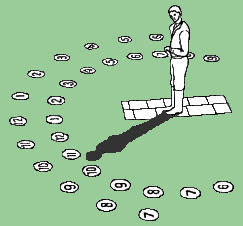Basic Terms of Time Services
Basic Terms of Time Services



Coordinated Universal Time (UTC) is a compromised time scale introduced in 1972. To ensure that UTC is kept within 0.9 seconds of UT1, provision was made for the introduction of " leap second" in the UTC scale whenever necessary. Thus, UTC differs from International Atomic Time (TAI) by an integral number of seconds. The decision to introduce a leap second in UTC is the responsibility of the International Earth Rotation Service (IERS) in Paris.
The Gregorian calendar, which is currently used in most countries of the world, was derived from the Julian calendar. In the Julian calendar, a mean length of 365.25 days for the year is adopted. The calendar year is adjusted to this mean value by inserting an intercalary day every four years. The intercalary or leap year has 366 days and each of the other three years has 365 days. The year with a numerical designation divisible by 4 would be a leap year. The mean Julian calendar year exceeds the length of the tropical year (365.2422 days) by about 11 m 14s.
In 1582, Pope Gregory XIII revised the Julian calendar and adopted a different rule for leap year by omitting the intercalary day in century years that are not divisible by 400. In the Gregorian calendar, there are 97 leap years (366 days a year) and 303 ordinary years (365 days a year) for every 400 years so that the mean Gregorian calendar year is 365.2425 days, quite close to the length of the tropical year of 365.2422 days.
Coordinated Universal Time (UTC), the basis for our civil time, is occasionally adjusted by one second called leap second to insure that the difference between a uniform time scale defined by atomic clocks does not differ from the Earth's rotational time by more than 0.9 seconds.
Since the first leap second in 1972, all leap seconds have been positive.
Julian Date (JD) and Modified Julian Date (MJD)
The world has been divided into 24 time zones, each centred on lines of longitude at 15 degrees intervals so that every country falls within one or more agreed time zone. The Greenwich Meridian (also called Prime Meridian) lies at centre of the first zone. Places west of this are one or more hours behind while those east of this would be in front of. In most places, local time differs from UTC by a whole number of hours, depending on the local time zone.
Hong Kong Standard Time (HKT) = Coordinated Universal Time (UTC)+ 8 hours.


